McDaniel College’s Student-Faculty Collaborative Summer Research Program leads to impactful virtual experiences
More than 40 students participated in McDaniel College’s Student-Faculty Collaborative Summer Research Program. The Student-Faculty Collaborative Research experience is a 10-week program for undergraduate students at McDaniel to pursue research, which is supported by donors. Thirteen faculty members have been leading projects virtually, while two Chemistry professors received special permission to perform COVID-19 research in labs on campus.

Chloe Irla, assistant professor of Art & Art History, with rising junior Liz Mince in their “A Baltimore/Carroll ABC Book."
More than 40 students took their explorations to new virtual heights through McDaniel College’s Student-Faculty Collaborative Summer Research Program.
Students examined the impacts of the pandemic from Baltimore to Carroll County, utilized technology to study the movements of goldfish, minnows and carps, explored topics surrounding multinational students in higher education and more.

Biology students examined the movement of goldfish, minnows and carps with Katie Staab, associate professor of Biology.
The Student-Faculty Collaborative Research experience is a 10-week program for undergraduate students at McDaniel to pursue research, which is supported by donors.
Thirteen faculty members have been leading projects virtually, while two Chemistry professors received special permission to perform COVID-19 research in labs on campus. From California all the way to Vietnam, students were able to remain connected to McDaniel and take their research outside the classroom.
The alphabet has many letters, and this summer “Z” stood for “Zoom,” according to “A Baltimore/Carroll ABC Book,” which is a double-cover book created by rising junior Liz Mince of Street, Md., and Chloe Irla, assistant professor of Art & Art History.
Mince and Irla utilized the video conferencing platform to collaborate on this book that includes one side dedicated to Baltimore City and the other to Carroll County. Readers must flip through the book to travel between the two locations, according to Irla, who noted the book is centered around the pandemic and includes data and locations affected by COVID-19 and its financial impact.
“This student-faculty research experience enabled me to appreciate the similarities and differences between Carroll County and Baltimore City,” Mince said. “While working on this project, I learned about the negative impact of the current pandemic and how COVID-19 caused people to behave differently in both geographic areas.”
The advancement of technology allowed Biology students to view high-speed videos and ask questions about the movement of goldfish, minnows, and carps as well as quantify distances and timings of fish feeding by clicking on anatomical landmarks in each frame, said Katie Staab, associate professor of Biology.
Rising senior José Pac of Quetzaltenango, Guatemala, spent his summer assembling and annotating nine bacterial genomes to get an idea of potential genetic pathways used by these bacteria while living with their coral hosts, according to Allison Kerwin, assistant professor of Biology.
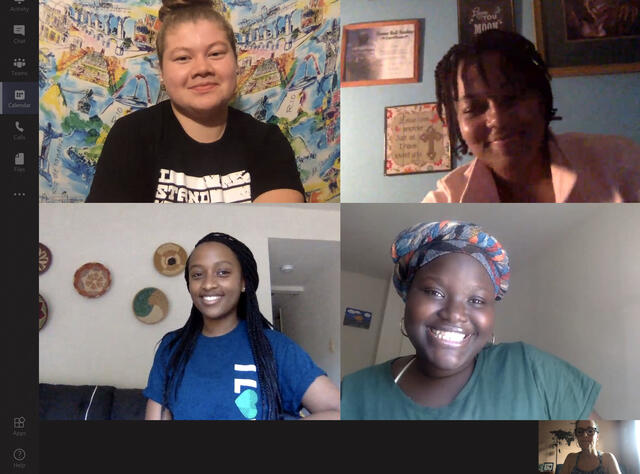
McDaniel students Ada Mejía, Natalya Nicholas, Inés Agasaro and Yelli Coulibaly meet with Amy McNichols, associate professor of Spanish and Global Bridge Program & International Student advisor.
A research team made up of Global Bridge students at McDaniel developed a survey that will be distributed to other multinational college students who immigrated to the United States during their childhood or adolescence in order to collect data about their experiences in different types of higher education institutions, said Amy McNichols, associate professor of Spanish and Global Bridge Program & International Student advisor.
“This was a really great experience and opened me up to wanting to do more research in general, but specifically with McDaniel. This birthed an even deeper desire in me to make a change regarding diversity and inclusion,” said rising sophomore Natalya Nicholas of Hyattsville, Md. “Having Dr. McNichols lead this research was perfect because she is an excellent teacher and research leader. I learned a lot from her that I will be taking with me through the rest of my college career.”
Students on the proposed research team with McNichols have been actively involved in Global Bridge programming for two to three years. McDaniel’s Global Bridge Program was devised in 2014 to create a network of support for students who call the U.S. home, but who were born in other countries that they also call home, according to McNichols.
Learn more about the virtual research projects this summer:
- Peter Craig, associate professor of Chemistry, collaborated on research entitled “The Case for Zinc Ejection” that focuses on shutting down severe acute respiratory syndrome coronavirus 2 (SARS-CoV-2) production in host cells and inhibiting Zinc containing proteins, that initiate virus production with Christian Brown of Boonsboro, Md., Patrick Keane of Germantown, Md., Jonah Ruskin of Kensington, Md., Colin Tucker of Keymar, Md., and Matthew Ulrick of Owings, Md. SARS-CoV-2 is the strain of coronavirus that causes COVID-19. Craig also worked virtually on "Ligand pre-assembly is necessary to prepare Schiff base nickel (II) complexes of tren with acetylacetone, salicylaldehyde or ortho-vanillin" with Makayla Patterson of Colorado Springs, Colo.
- Elly Engle, assistant professor of Environmental Studies, collaborated on “Seeding Change Through Experiential Learning: A Seed Library Project,” with Sarah Cowan of Bel Air, Md., which is a continuation of a student-led project started in Fall 2019 that included students engaging with community partners to develop a new seed library project in Carroll County. Cowan has been transcribing recordings, conducting interviews with community partners, finalizing the initial proposal, participating in a grant writing training course and is planning to present with Engle about the initial process and findings at the Association for Environmental Studies and Sciences virtual professional conference. This work has also been supported financially by the Nora Roberts Foundation Faculty Award for Community Engagement.
- Qin Fang, associate professor of History, collaborated on “Digital History: Water, Food, and Environment” with Kyra Greenfield of Beltsville, Md., and Juliette Marchman of Columbia, Md.
- Dana Ferraris, associate professor of Chemistry, collaborated on research efforts to discover drugs to treat COVID-19 with Max Gosselin of Mount Airy, Md., Zach Kiick of Gettysburg, Pa., Jayce Klingenberg of Hampstead, Md., Zoey Nichols of Princess Anne, Md., and Priscilla Owusu of Bowie, Md.
- Chloe Irla, assistant professor of Art & Art History, created a double-cover book, entitled “A Baltimore/Carroll ABC Book” with Liz Mince of Street, Md.
- Allison Kerwin, assistant professor of Biology, collaborated on research entitled "Comparison of tropical coral-associated bacterial genomes," which looked at assembling and annotating nine bacterial genomes with José Pac of Quetzaltenango, Guatemala.
- Richard Laird and Jennifer McKenzie, associate professors of Kinesiology, collaborated on “Does Exercise Training Improve Grit and Resilience in College Students?” with Nicholas Bowman of York, Pa., Samantha Kline of Smithsburg, Md., Katheryn Morrow of Poolesville, Md., Tanya Romero of Gaithersburg, Md., and Josh Sproul of Princess Anne, Md.
- Paul Lin, assistant professor of Mathematics & Computer Science, collaborated on “Deep Learning using TensorFlow,” where students Jamal Bourne of Reisterstown, Md., Abigail Gonzalez of Baltimore, Christopher McDonald of Brookeville, Md., and Mason White of Savannah, Ga., continued machine learning research from last summer, while focusing on using Neural Network as the learning model as well as utilizing TensorFlow and its playground as programming tools for experimenting.
- Amy McNichols, associate professor of Spanish and Global Bridge Program & International Student advisor, developed a survey that will be distributed to other multinational college students who immigrated to the United States during their childhood or adolescence in order to collect data about their experiences in different types of higher education institutions with Ada Mejía of Silver Spring, Md., Inés Agasaro of Baltimore, Natalya Nicholas of Hyattsville, Md., and Yelli Coulibaly of Silver Spring, Md.
- Paul Muhlhauser, associate professor of English, collaborated on “Program and Control: Black Mirror's ‘Bandersnatch’ Coercive Communication, and Utilizing Disbelief” with Sera McClintock of West Chester, Pa., “Grilling Meataphors: Rhetoric, Ideology, and Eating ‘Meat’” with Rachel Reitz of Sykesville, Md., “Branding, Engaging, and Creating Compelling Content for Academic Social Media” with Tara Salvati of Poughquag, N.Y.
- Katie Staab, associate professor of Biology, collaborated on research that focuses on the mechanics in cypriniform fishes, which include goldfish, minnows and carps with Kendall Hanak of Highlands Ranch, Colo., Davin Hong of Sykesville, Md., and Mackenzie Meyer of San Jose, Calif.
- Benjamin Steinhurst, associate professor of Mathematics & Computer Science, collaborated on research entitled "Fibonacci Fractals and Recursively Stable Words" with Nicholas Cummings of Falls Church, Va., Suyi Gao of Xiamen, Fujian, China, Lan Mai of Ho Chi Minh City, Vietnam, and Matthew O’Neill of Port Deposit, Md.
- Corey Wronski-Mayersak, associate professor of English, collaborated on “The McDaniel Medieval Ghost Mapping Project” that entailed mapping ghosts from Icelandic/Viking sagas with Stephanie Eckard of Westminster, Md.
- Ting Zhang, assistant professor of Mathematics & Computer Science, collaborated on “Machine Learning for Video Classification” with Blair Boyle of Springfield, N.J., and Collin Moran of Taneytown, Md., exploring machine learning techniques like logistic regression, random forest, and deep learning, learned to design and implement convolutional neural network (CNN) models for efficient video classification.
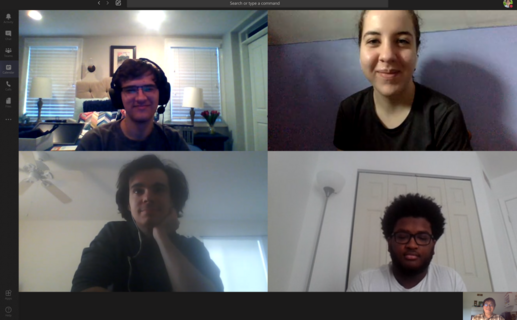
McDaniel students Mason White, Abigail Gonzalez, Christopher McDonald and Jamal Bourne with Paul Lin, assistant professor of Mathematics & Computer Science.
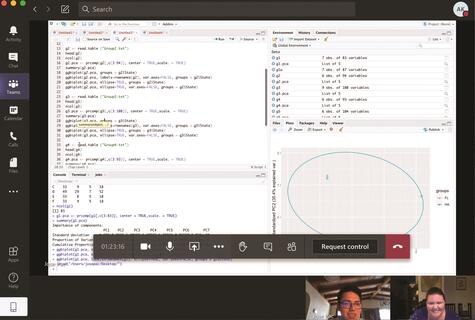
Allison Kerwin, assistant professor of Biology, with student José Pac.
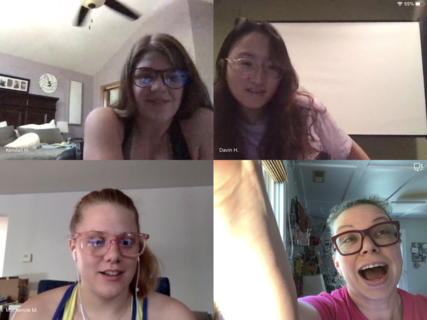
McDaniel students Kendall Hanak, Davin Hong and Mackenzie Meyer with Katie Staab, associate professor of Biology.
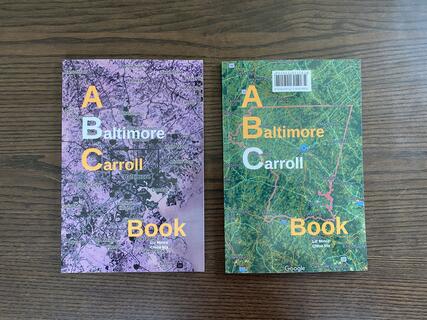
“A Baltimore/Carroll ABC Book," created by student Liz Mince and Chloe Irla, assistant professor of Art & Art History.
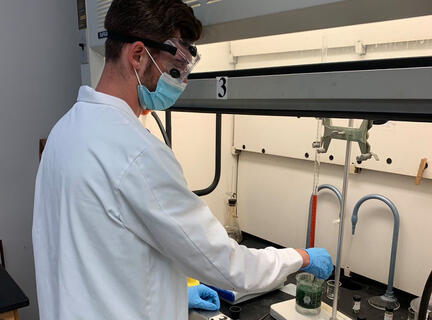
McDaniel student Matthew Ulrick works on research with Peter Craig, associate professor of Chemistry.
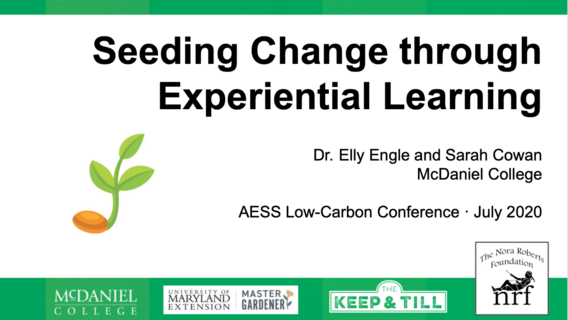
Elly Engle, assistant professor of Environmental Studies, collaborated on “Seeding Change Through Experiential Learning: A Seed Library Project,” with McDaniel student Sarah Cowan.

McDaniel students Ada Mejía, Natalya Nicholas, Inés Agasaro and Yelli Coulibaly meet with Amy McNichols, associate professor of Spanish and Global Bridge Program & International Student advisor.